Perfect, fluffy, soft, and flavorful French Vanilla Cake. Every baker needs a reliable, foolproof vanilla cake recipe up their sleeve - and this French Vanilla Cake is about to become your new favorite!
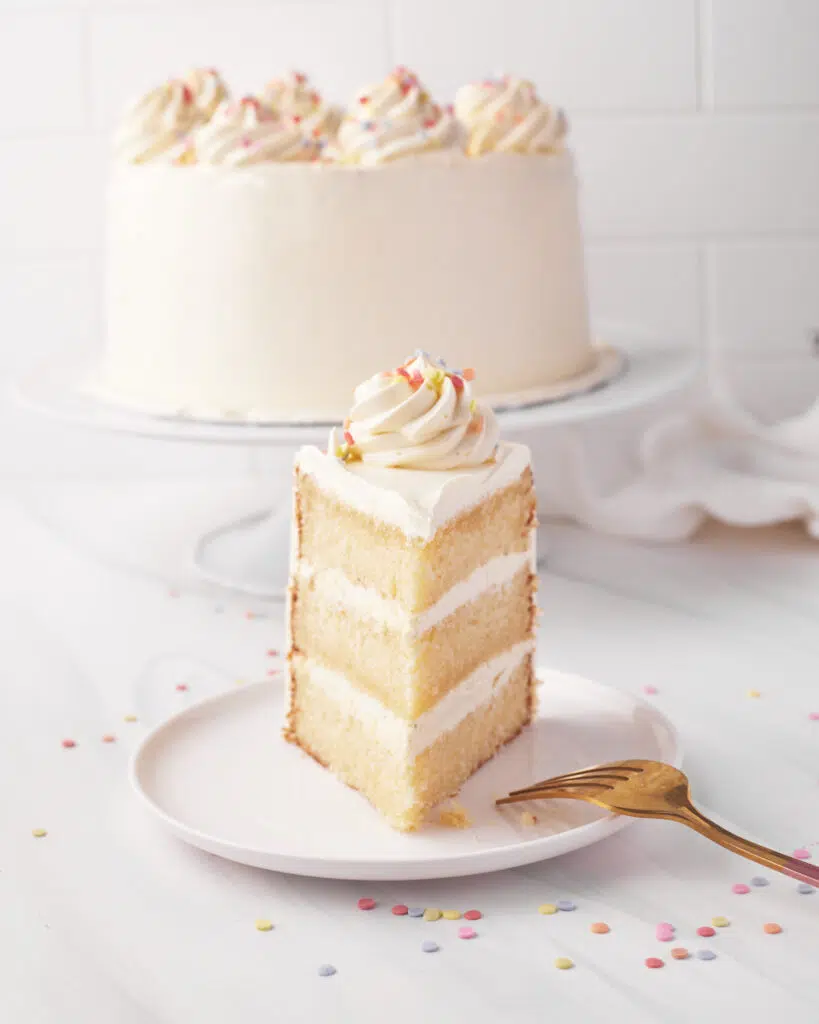
Reader Review:
Made this for my daughter's birthday cake…Everyone at the party was raving about how delicious the cake was. Super fluffy and moist, but still sturdy. The reverse creaming method was explained really well and I think it made a difference! I'll be using this recipe exclusively for all my vanilla cakes now.
⭐⭐⭐⭐⭐ - Emily
Vanilla has a reputation for being 'basic' or 'boring'. But the truth is Vanilla is anything but! Not only is it a deep and complex flavor in its own right, but vanilla cake is a solid foundation for so many amazing, delicious cakes and desserts.
French vanilla cake is a classic choice for birthday cakes and for wedding cake as it's such an amazing flavor that most people enjoy. It's also so versatile and can be mixed with so many different frostings and fillings.
This French vanilla cake is my go-to vanilla cake recipe and the base of many of my most popular posts, including my Vanilla Custard Cake and my Mango Cupcakes. Just like my Berry Chantilly Cake, this uses the reverse creaming method, which makes for an incredibly soft and luxurious texture. Not only is the flavor incredible, but the texture is out of this world - when you put your fork into it, the slice cuts just like butter! Welcome to your new favorite perfect vanilla cake recipe!
Jump to:
What is French Vanilla Cake?
Many people assume that the thing that makes it 'French' vanilla is the origin of the vanilla that is used in the recipe, such as with 'Tahitian vanilla' or 'Madagascan vanilla. - that's actually incorrect. Rather than it being about a specific French vanilla extract, the flavor of 'French Vanilla' actually originated with ice cream and referenced the French method of making ice cream which was made with a custard base (i.e. egg yolks and milk/cream) That delicious, custardy flavor is what is known as French Vanilla. When referring to cake, it means a vanilla cake that uses both egg whites and egg yolks in the recipe, as opposed to your typical white cake recipe which will only use egg whites.
When most people today think of the flavor of French vanilla cake, they picture the easy french vanilla cake mix from Betty Crocker kitchen. But as you know, we don't do box cake mixes around here! A homemade vanilla cake recipe from scratch will beat out a box cake mix any day. This recipe uses simple ingredients and easy steps to make the best french vanilla cake you've ever had.
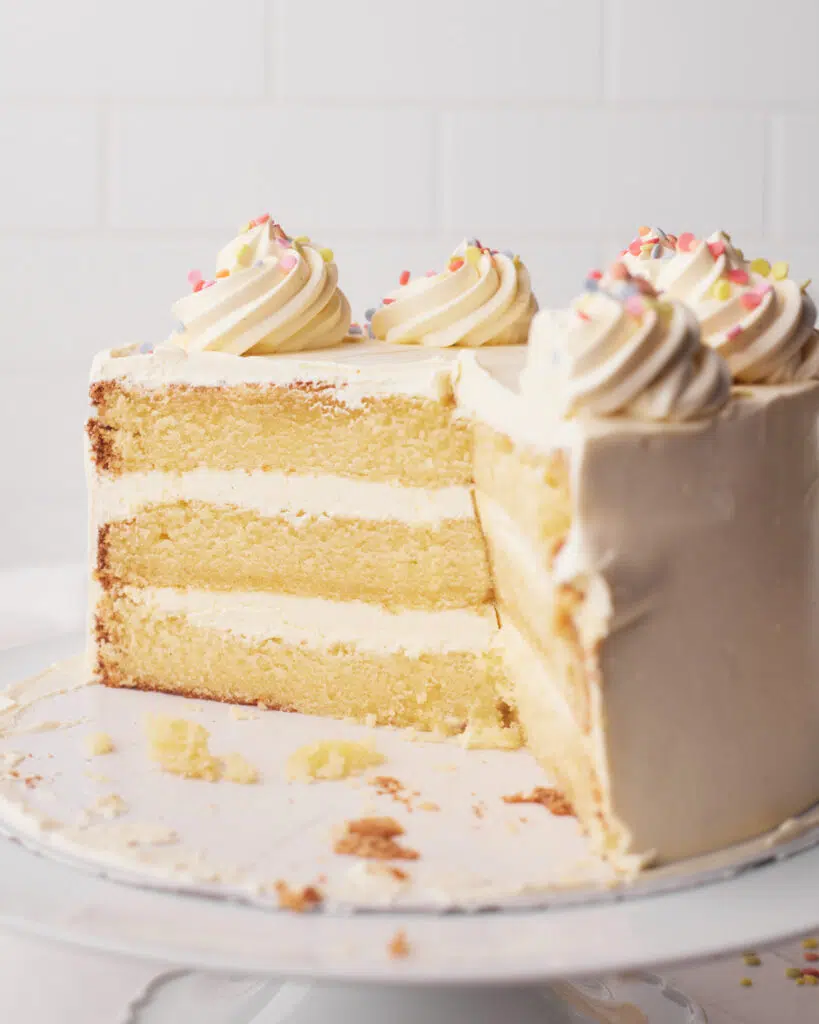
Simple Vanilla Cake Recipe Ingredients
- Milk - Milk is what makes this vanilla sponge cake so fluffy and velvety, when you put your fork through it it cuts like butter! Make sure you use whole milk.
- Oil - Using oil makes a very moist cake. I use vegetable oil but any flavorless oil will do - e.g. canola oil or sunflower oil.
- Flour - I find the best results for this cake come from using cake flour, it makes a super tender crumb. But if you can't get ahold of cake flour then all-purpose flour (plain flour) will still be great.
- Sugar - Using white sugar is best to show off the delicious vanilla flavor. Make sure you use superfine sugar (caster sugar in the UK).
- Eggs - We'll be using whole eggs in this cake recipe. Always use large eggs when baking and try to use free-range if you can.
- Butter - Use unsalted butter and make sure it is at room temperature before beginning.
- Vanilla - Of course, we need vanilla for a french vanilla cake. Contrary to popular belief, what makes it a 'French Vanilla' cake isn't the type of vanilla you use (see section below about 'What is French Vanilla?'. So you can use any kind of vanilla extract or vanilla bean paste that you like. Since vanilla is the star of the show, try to find a high-quality pure vanilla extract. And try to avoid vanilla essence.
See recipe card for quantities.
Equipment
- Stand mixer with the paddle attachment or an electric mixer.
- 2 x 8-inch cake pans
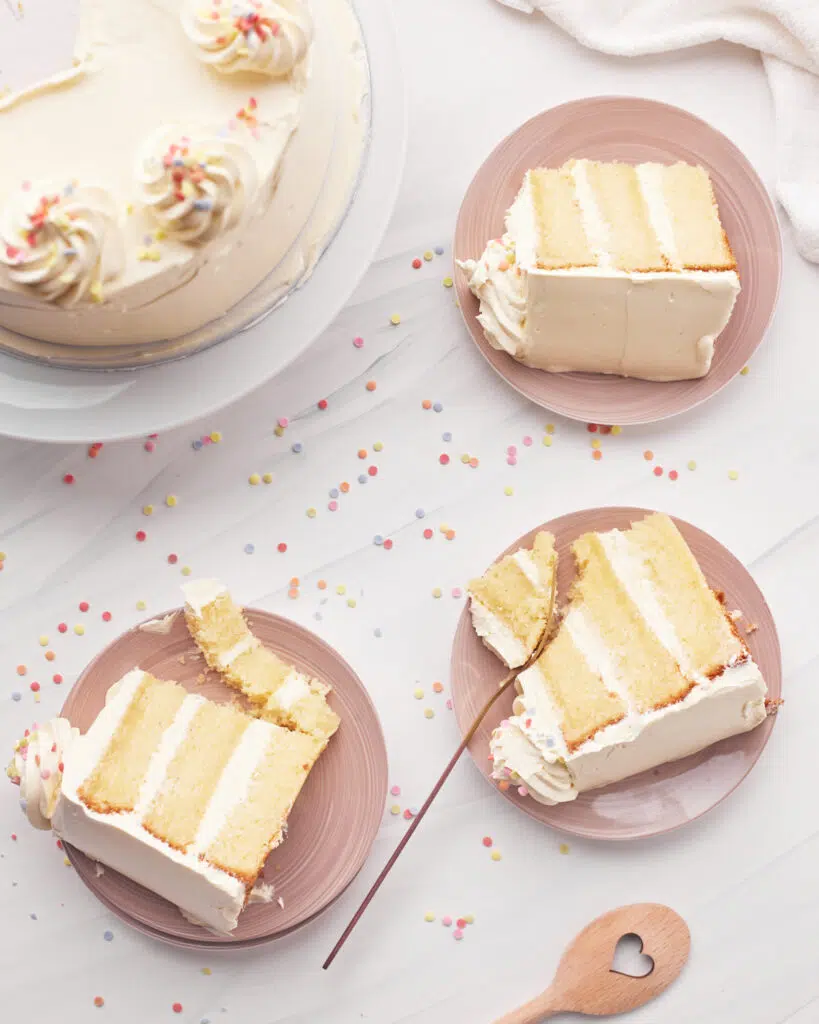
How to Make Homemade Vanilla Cake
This French vanilla cake recipe uses the reverse creaming method, which means combining all the dry ingredients with the butter first, rather than creaming the butter with the sugar. It sounds crazy at first but they are super simple steps that will give you a perfect, decadent french vanilla cake.
- Heat oven to 335°F / 170°C and grease two 8-inch round pans. I also like to put some parchment paper cake circles in the bottom of the pans to ensure they do not stick at all.
- Split the milk into two containers, one with ½ cup of milk (118g) and one with ¾ cup of milk (177g).
- Mix the ½ cup of milk with the vegetable oil and set aside.
- Mix the ¾ cup of milk with the eggs and vanilla and set aside.
- Place the flour, sugar, baking powder, and salt into the bowl of your stand mixer and turn it on low speed with your paddle attachment. You can also do this with an electric mixer and a large bowl, but I wouldn't recommend trying to do it by hand.
- Slowly add the butter, one small chunk at a time, letting it mix into the flour mixture for a few seconds in between additions. Once it's all in it should look kind of like chunky breadcrumbs
- Add the first lot of wet ingredients - the milk and oil mixture and slowly turn your mixer up to a medium speed. Beat for exactly two minutes.
- Scrape the sides of your bowl to make sure there are no lumps, then turn the mixer back on low speed.
- Add the milk and egg mixture slowly and mix on low speed until just combined.
- Divide the cake batter into the prepared cake pans and bake for 30-40 minutes or until a skewer inserted into the center of the cake comes out clean.
- Remove from the oven and let cool in the cake pans for at least 30 minutes before transferring to a wire rack to cool.
- Once cooled, sandwich the cake layers together with your favorite frosting and decorate. I used my Russian Buttercream recipe for this cake, but see the section below for ideas on perfect pairings for this French vanilla cake.
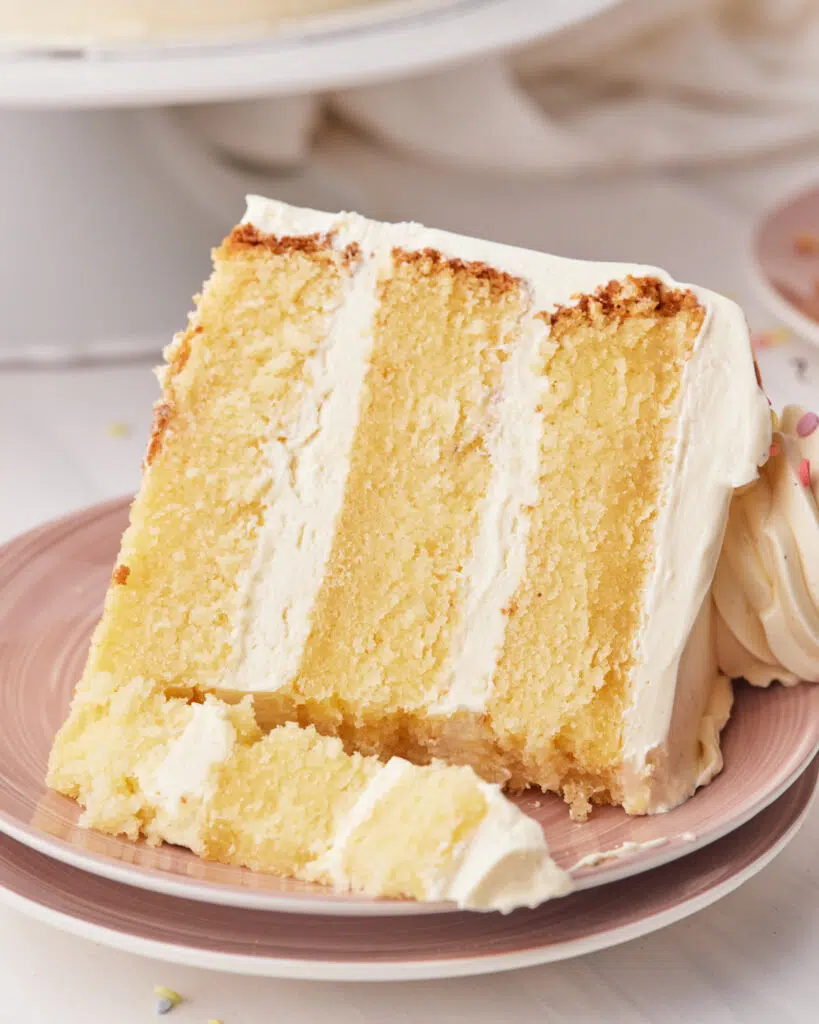
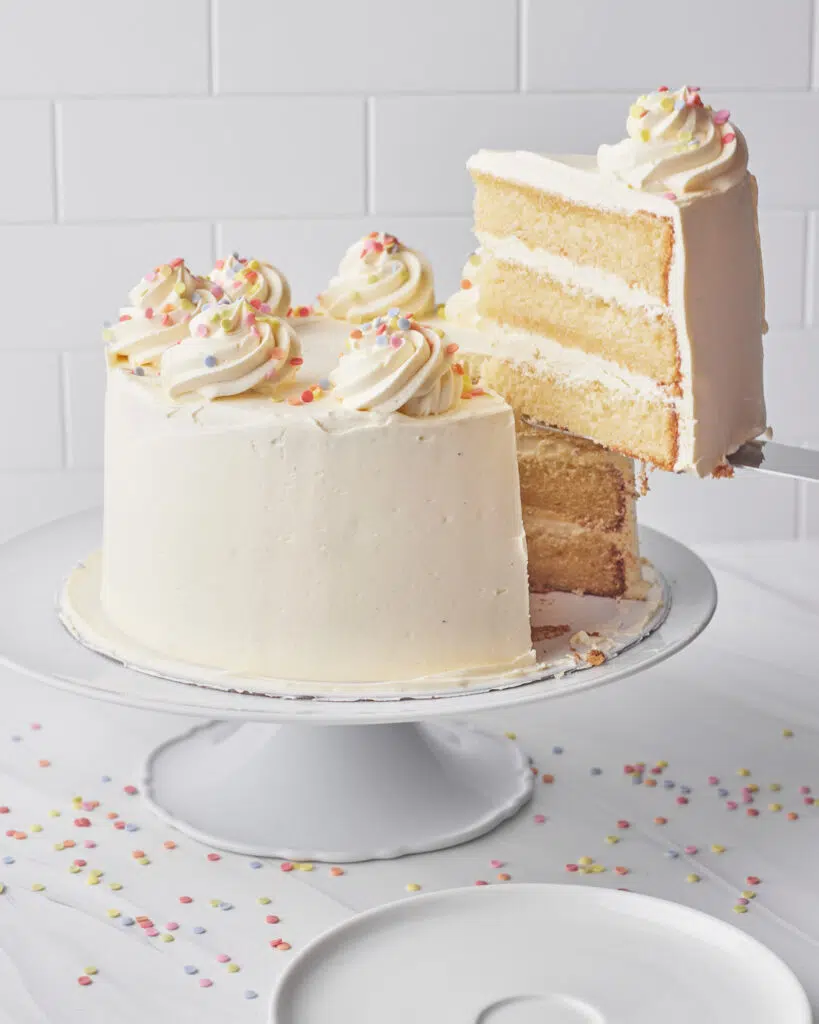
Homemade Vanilla Cake Recipe Frosting Pairings
The fun thing about vanilla cake is that basically, any flavor goes with it! For a classic vanilla flavor, you can stick with vanilla buttercream, but even then there are so many options to choose from! I used Russian buttercream for the cake in the photographs.
American Buttercream: A very sweet and rich and a little thicker than other buttercreams. It is the classic frosting you are probably used to from store-bought cakes.
Italian Meringue Buttercream: A much more sophisticated frosting that is silky smooth and luxurious and a lot less sweet than American buttercream. It is a little longer and more complicated to make though.
Russian Buttercream: My current favorite and what I used to frost this cake is Russian Buttercream. In my opinion, it has the best of both worlds as it has the glossy, smooth texture of Italian Meringue Buttercream but has only two ingredients and is super easy to make.
Chocolate Buttercream: For a fun twist, try a chocolate version by adding my Easy Chocolate Buttercream Frosting
Any of these buttercreams can be mixed with other ingredients to flavor them and create a world of different flavor combinations. For example, I recently mixed Russian Buttercream with raspberry coulis to create the frosting on these delicious Raspberry Cupcakes.
Here are some other posts with more of my favorite frostings you can try with this cake:
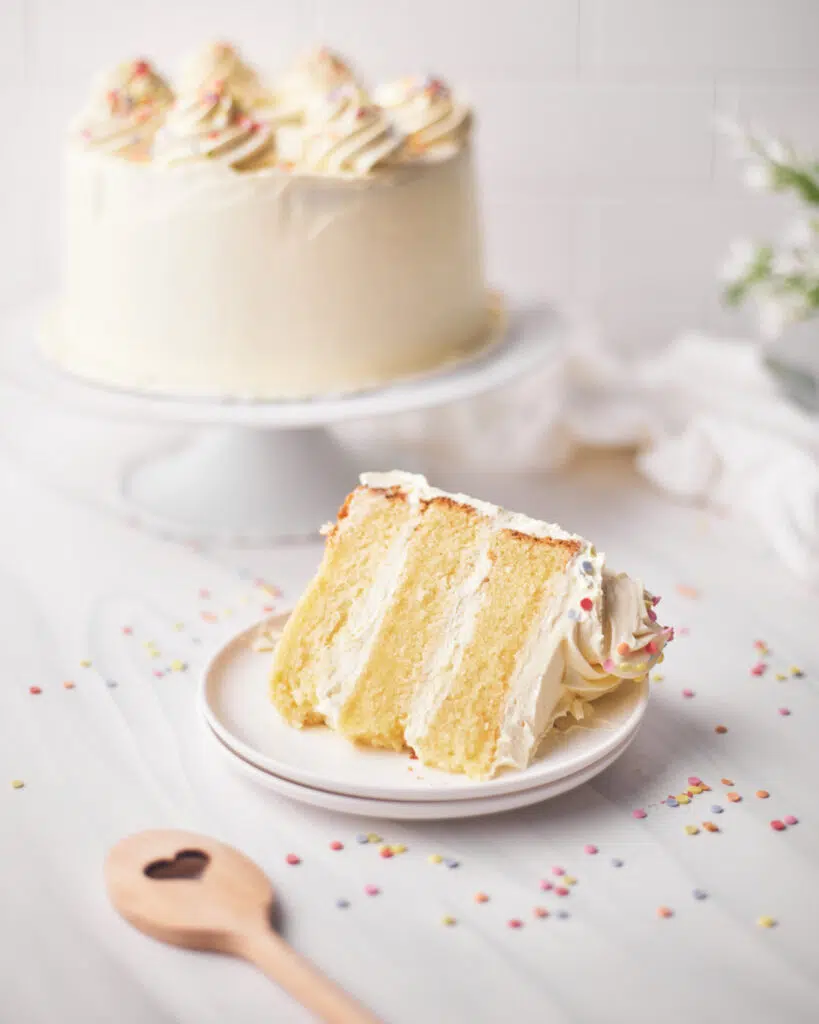
Tips For Decorating French Vanilla Cake
How you choose to decorate your cake is entirely up to you. But here's an idea of how I decorated mine.
- Decide how many layers you want to have in your cake. If you want two cake layers you can just use the layers you baked in the two tins. For a slightly taller layer cake, you can cut each of those layers in half to make four total layers.
- Note: For the cake I photographed here I actually doubled the recipe and made three cake layers and used one-quarter of the recipe to make cupcakes (yes you can use this recipe for cupcakes too!).
- Cut the domed top off of the cakes and slice them according to how many layers you want. I like to use a cake leveler to ensure perfectly even layers, but you can also use a serrated knife.
- Stack the layers with your chosen frosting, spreading an even amount of frosting in between each layer.
- Make a crumb coat by spreading a very thin layer all over the sides of the cakes and on top of the cake. Let chill for 15 mins.
- Spread a much thicker layer of frosting all over the cake and smooth out using a spatula or bench scraper.
- Once you are happy with the frosting, you can put some of the frosting in a piping bag with a star nozzle and pipe some rosettes on top.
- Cover with sprinkles to your heart's desire.
Top Tip: For extra smooth frosting, run the spatula or bench scraper under hot water for a few seconds to make it warm, then dry quickly with a paper towel - do this in between swipes of the frosting.
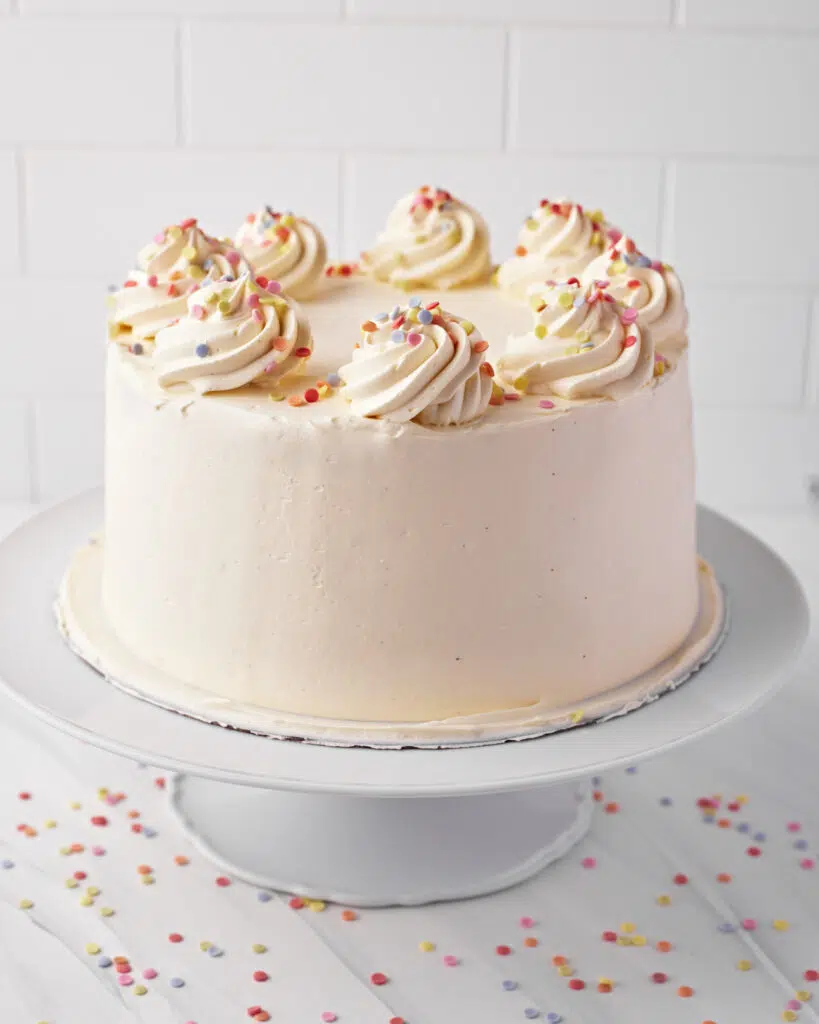
Fluffy Vanilla Cake Recipe Variations
As I mentioned before, this recipe is super versatile.
Layer Cakes - You can use it to make any number of layer cakes such as my Vanilla Custard Cake or Chocolate German Layer Cake.
Cupcakes - You can also use this exact same recipe to make cupcakes, see my perfect vanilla cupcakes post for that version. The recipe as is will make about 24 cupcakes.
Bundt Cake - The recipe will work for a bundt cake, but it is a very fragile cake so make sure you are very gentle when removing it from the bundt pan as you don't want it to break! Also. make sure to thoroughly grease your bundt pan.
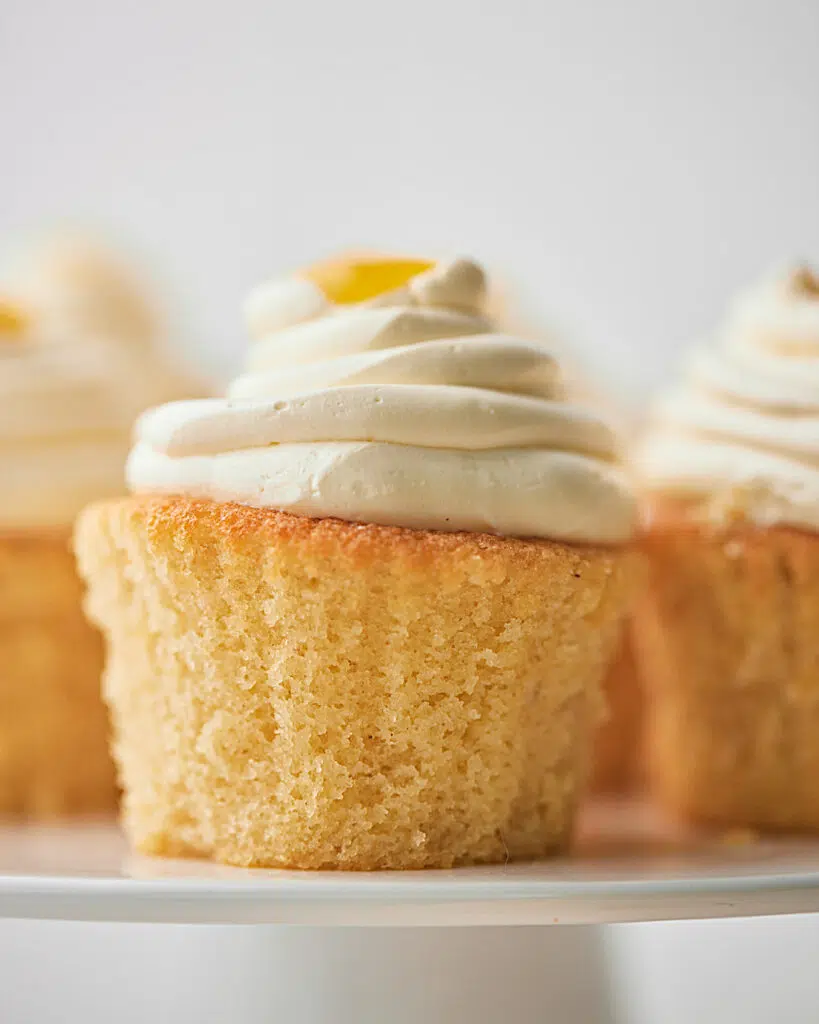
Storing Homemade Vanilla Cake
The baked, unfrosted vanilla cakes can be stored wrapped in plastic wrap and in an airtight container for 3 - 5 days.
Once they are decorated, you may or may not need to store them in the fridge depending on what kind of filling you used. If you used a frosting like a Custard Buttercream then you will need to store it in the fridge in an airtight container.
If your frosting does not need to be refrigerated, it's best to store it in an airtight container at room temperature.
FAQ
The reverse creaming method is an alternative method of combining the cake ingredients. The typical way to start a cake is to cream the butter and sugar together until light and fluffy and then add the eggs, vanilla and eventually flour and milk. In the reverse creaming method, we start by cutting the butter into all the dry ingredients - including the flour. By coating the flour with butter, you are limiting the gluten development which helps keep the cake tender and fluffy. An added benefit I have noticed is that cakes made with the reverse creaming method tend to come out flatter than other cakes (i.e. less of a dome on top).
There are a number of things that can cause a cake to sink, but it is typically due to the centre being underbaked. See my post about why cakes sink to troubleshoot and find out how to prevent cakes from sinking.
More Classic Cake Recipes
Satisfy your cake cravings with some of these classic cake recipes:
Recipe
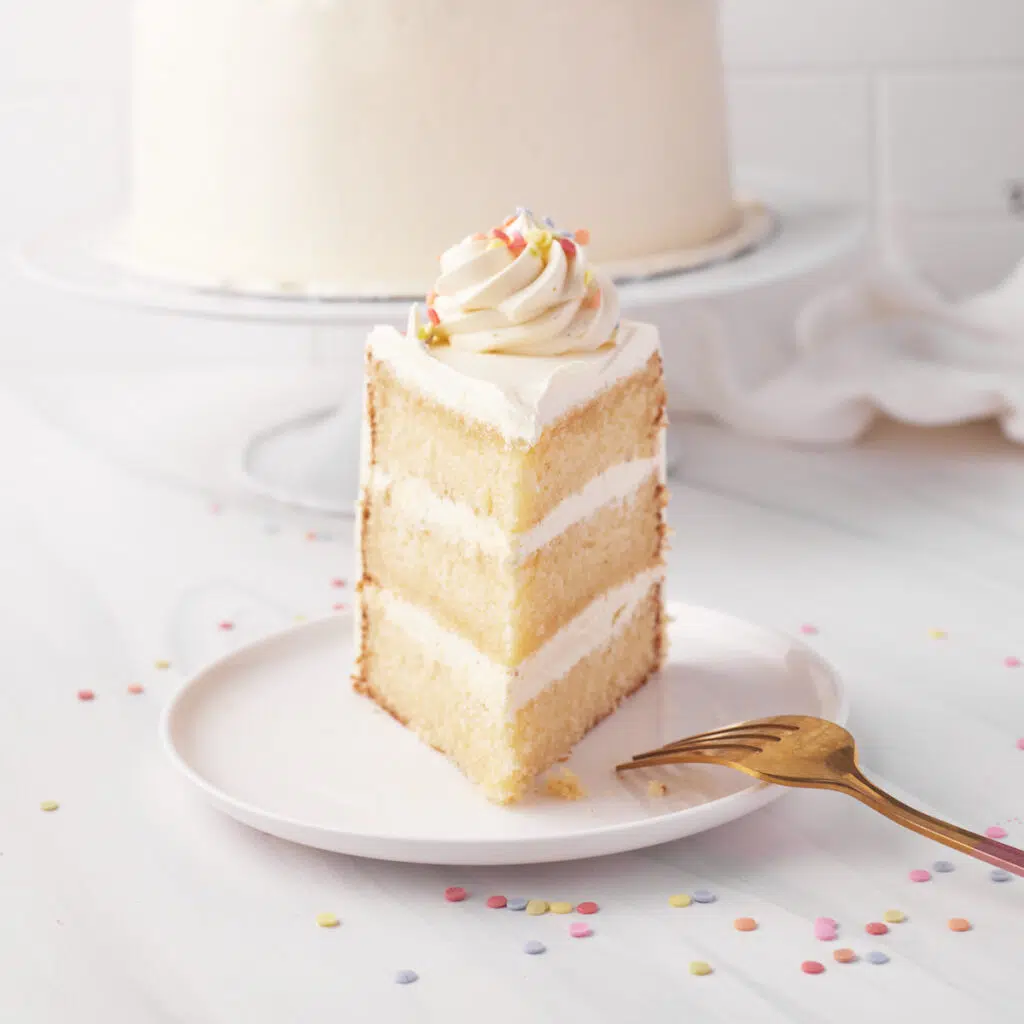
Homemade Vanilla Cake Recipe
Ingredients
- 1 ¼ cups Whole Milk 300ml (room temperature)
- ⅓ cup Vegetable Oil 80ml
- 3 Large Eggs (room temperature)
- 2 ¾ cups Cake Flour 312g
- 2 sticks Unsalted Butter 227g (room temperature)
- 1 ¾ cups Granulated Sugar 350g
- 1 tablespoon Baking Powder
- ½ teaspoon Salt
- 2 teaspoon Vanilla Extract
Equipment
- Stand Mixer with paddle attachment
Instructions
- Preheat oven to 350°F / 180°C (160° fan-assisted) and grease two 8-inch cake pans.
- Split the milk into two containers, one with ½ cup of milk (118g) and one with ¾ cup of milk (177g).1 ¼ cups (295 g) Whole Milk
- Mix the ½ cup of milk with the vegetable oil and set aside.⅓ cup (72 g) Vegetable Oil
- Mix the ¾ cup of milk with the eggs and vanilla. Whisk together lightly and set aside.3 Large (3) Eggs, 2 teaspoon (1 tbsp) Vanilla Extract
- Sift the flour, sugar, baking powder, and salt into the bowl of your mixer and turn on low with your paddle attachment.2 ¾ cups (312 g) Cake Flour, 1 ¾ cups (350 g) Granulated Sugar, 1 tablespoon Baking Powder, ½ teaspoon (½ tsp) Salt
- Slowly add the butter, one small chunk at a time, letting it mix for a few seconds in between additions. Once it's all in it should look kind of like chunky breadcrumbs2 sticks (227 g) Unsalted Butter
- Add the milk/oil mixture and slowly turn your mixer up to a medium speed, just so it doesn't splash. Beat for exactly two minutes.
- Scrape the sides of your bowl to make sure there are no lumps, then turn the mixer back on low.
- Add the milk/egg mixture slowly and mix on low until just combined.
- Divide into cake pans and bake for 30-40 minutes or until a skewer comes out clean.
- Take them out of the oven and let them cool in the pan for at least 30 minutes before removing and putting on a wire rack to cool.
- Fill and frost with your favourite frosting. I used my Russian buttercream recipe for a silky smooth and sweet vanilla filling.

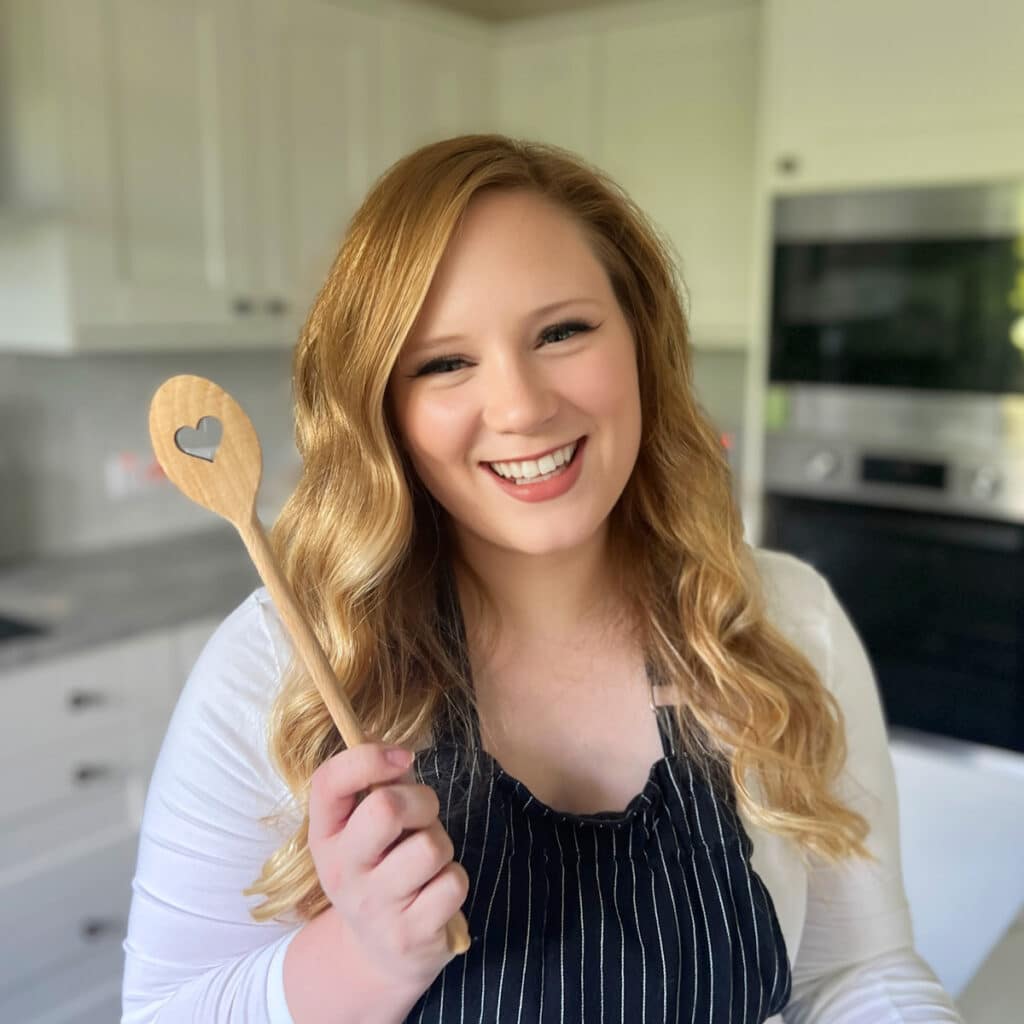
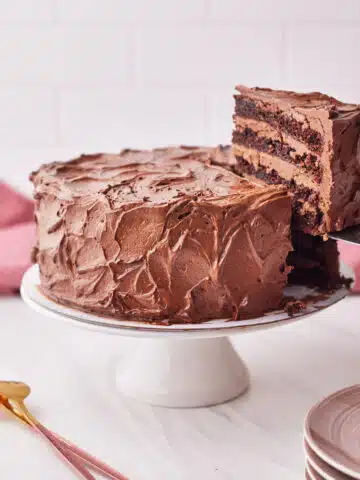
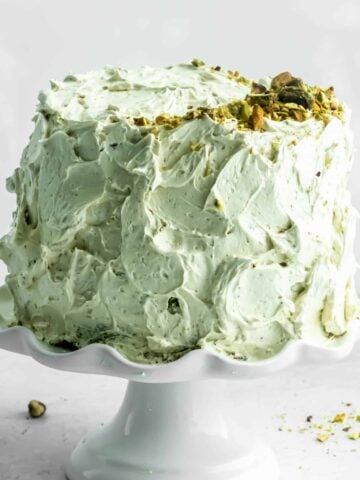
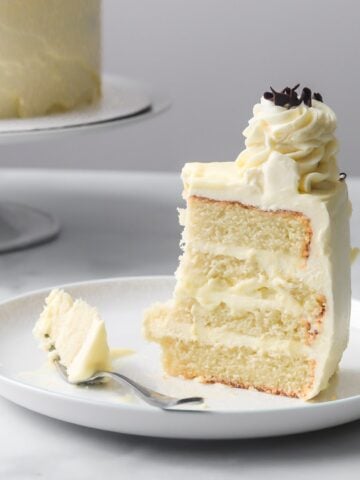
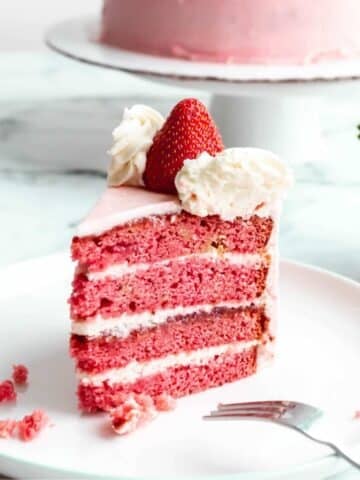

Kathy
Can I use a 9x13 pan ?
Jules Grasekamp
Hi Kathy,
Yes you can use a 9x13 pan - just make sure to watch closely for the signs that it is baked as it won't take as long to bake as in a round pan.
Jules
Christina Marie
I've never successfully made a cake from scratch before so please excuse my silly questions... If I'm doing a 3 layer 10" cake, do I increase the recipe to "large" when I print it? Also, have you ever substituted applesauce for the vegetable oil in this recipe? I do it in every cupcake recipe and it always works but maybe things are different when making a big layered cake. Lastly, could I use a marscapone chantilly cream frosting or something lighter than the russian or butter based frostings? This cake is for my daughter's 21st birthday and she doesn't love heavy butter frostings. That being said I don't know whether or not a lighter frosting will be stable enough for 3 layers. I don't want the frosting to squish out between the layers. Thoughts?
Natalie Keune
I want to make this for my friends birthday but I only have one 8inch pan (it’s rather high though), can I bake it as one cake and then cut the layers or do I have to bake twice in that one pan?
Jules Grasekamp
Hi Natalie,
That's a great question. Generally I wouldn't recommend trying to do this in one pan. Even though the batter may fit, if the cake pan is too full it could mean the outside of the cake bakes faster than the middle and cause the cake to sink. If you don't have two pans then yes I would recommend baking it in two batches. Sorry I can't be more helpful!
Jules
Natalie Keune
Hi Jules,
Thanks for the reply, I ended up baking in one pan. Baking time was significantly increased but the cake came out fine in the end. I used a thermometer to make sure it is fully cooked 😊 I used German buttercream and candied pecans to fill and decorate and it was an absolute hit!
Jules Grasekamp
Oh that's great to hear! I'm so glad it worked out well for you, it sounds like you did all the things necessary to make sure it worked! I tend to err on the side of caution with these recommendations as not everyone has that level of baking knowledge and I don't want anyone to be disappointed!
Ooh German buttercream and candied pecans sounds absolutely divine! I might need to try that combo for myself!
Thank you for trying my recipe and for letting me know how it turned out 🙂
Jules
Maria
Hi! The picture has three cake layers but the recipe calls for two pans. Is this recipe enough for a three layer cake using 8 inch pans? Thanks!
Jules Grasekamp
Hi Maria,
I mentioned in the notes of the recipe that I used a double batch of the recipe for this shoot day and split it into 4 - using 3 for the cake layers and 1 for a batch of vanilla cupcakes. Typically I make two layers with most of my cakes, so that is why the recipe is written this way, however you can absolutely split the regular recipe into 3 cake pans and bake them for a few minutes less - just look out for the signs that they are baked as described in the post.
Sorry for the confusion and I hope this helps!
Jules
Sher
Hi
Thanks for posting this recipe, they are delicious. I have a question for you. This is my fourth time making this recipe & I dont understand exactly what happens to them when I take them out. One they shrink alot secondly the recommended time for baking the cupcakes is between 30-40 min but mine are done within 20 min at 170 degrees centigrade which I find very odd. Does this have to do with my portable electric oven or something else. The tops become brown but then they sink while cooling. Is that because of too much liquid. Can you please advice
Jules Grasekamp
Hi Sher,
Are you looking for the vanilla cupcakes recipe? This is the french vanilla cake recipe. It is the same base recipe but the bake time is definitely very different. The cupcakes should only take about 18 minutes to bake.
As for the sinking, there are a few things that could cause this. It could be that your oven is heating unevenly - portable ovens will often put the heat on and off throughout a bake so the temperature can be fluctuating quite a bit in there. The oven temperature may also not be accurate, if it is too hot or too cold this could be causing the sinking. Try getting an oven thermometer to test what the temperature is actually doing inside the oven.
It could also be that the cupcake cases are being filled too full - you only want to fill them about 3/4 of the way. Or the other reason could be overmixing.
I hope this helps and that your next batch turn out perfectly!
Jules
Gabi Gilbert
Would it be okay to use 9inch pans?
Jules Grasekamp
Hi Gabi,
Yes you can definitely use 9-inch cake pans for the vanilla cake. The layers will be slightly thinner so you might want to check the cake in the oven a few minutes earlier than if you were using 8-inch. But it will still work great 🙂
Jules
Andie Baker
Hello! So excited to try this recipe, but I wanted to ask your advice before diving in. For making this French vanilla cake, I want to use your Russian Buttercream recipe with the added raspberry coulis that you use in the cupcake version. Would you recommend adding the same amount (1/2 cup of raspberry coulis) for the cake recipe?
Also I want to use smaller 6" heart shaped pans (Valentine cake!) instead of the 8" pans. Aside from having some extra batter would that completely throw off the recipe?
Thank you!
Jules Grasekamp
Hi Andie,
Ooh this sounds like a beautiful Valentine's Cake!
Yes I would recommend using the same amount of coulis, but you can do more or less according to your taste, it won't mess with the consistency of the frosting too much.
The recipe should work fine in the smaller heart-shaped pans, just make sure you don't overfill them or the cake may not bake properly. Of course, the bake time will be less as well, so just keep an eye out for the signs that the cake is baked and ready to come out of the oven.
I hope your cake turns out beautifully - I'd love to know how it goes!
Jules
Andie Baker
It turned out wonderfully! The softest cake I’ve ever baked and very moist. I’m normally a chocolate gal but this might have converted me. 🙂 Thank you for all the help!
Andie
Jules Grasekamp
Hi Andie,
Ah I'm so happy to hear this! Thank you for trying my recipe and for taking the time to let me know you loved it!
Jules
Emmalee
Should this cake with the sweetened condensed milk/butter frosting be refrigerated?
Jules Grasekamp
Hi Emmalee,
No there is no need to refrigerate it, in fact it's best stored at room temperature, even with the Russian buttercream on there. Store it in an airtight container at room temperature for up to 3 days.
The exception to this is if you mix any kind of fresh fruit or other dairy into your frosting - if that is the case it is best in the fridge.
Hope this helps!
Jules
Celisse
I have made a lot of cakes and this was by far the worst cake recipe I’ve ever tried. The cakes were not baked after 40 minutes. I finally took them out of the oven because they were turning so brown on top and the toothpick finally came out clean, but they completely sunk in the centers. I followed the recipe exactly and did the measurements in grams to be most accurate. What a disappointment.
Semaj
Hi I’m making a cake for my sister-in-law bridal shower and I was looking at the recipe for the baking temperature and it says 335F, my oven does have that temp so what do I put it on?
Jules Grasekamp
Hi Semaj, What temperature settings does you oven have on it?
If I know that then I can help!
Thanks
Jules
Emmi
I would recommend using half and half or heavy cream in place of the milk. French vanilla flavors involve whole eggs sugar and deep rich creamy flavor.
Milk will not have that added cream flavor. That half & half will add to the cake batter.
Cake is so yummy!
Jules Grasekamp
Hi Emmi,
That's a great suggestion. You can definitely use cream or half and half instead.
Thanks for trying my recipe, I'm so glad you liked it!
Jules
Emmi
Just a suggestion to all those who have made or WILL make this recipe.
Instead of “milk”
Use Heavy Whipping Cream instead.
More milk fat and more creaminess to add that Layer of French to a French Vanilla Flavor profile.
French Vanilla is CREAMIER & Sweeter & Thicker
on the tongue because of the Eggs and the Heavy Cream with more fat content.
The results are a truly tender well moistened cake crumb texture with that Creamier Vanilla version that French Vanilla is truly recognizable as.
Trust Me!
I make a yellow cake using heavy whipping cream and it’s delicious like from a “Pro-bakery shop”.
Lynn
Is it really 1-1/2 Tablespoons baking powder for this cake. That seems like a lot. Just want to be sure.
Lynn
Looking forward to trying this. What is the weight of eggs used. In US 1 large egg is 50 grams out of shell. Wondering if the same in UK.
Jules Grasekamp
Hi Lynn,
UK egg sizes are actually marginally bigger than US eggs. My recipes are formulated for US bakers as that's where most of my readers are (even though I live in Scotland!). However, this recipe will work with either UK or US large egg sizes, there is no need to make any adjustment as the difference is so small it will not affect the end result.
Hope this helps,
Happy baking!
Jules
Lynn
Thanks so much for your response and for all the information and recipes you share. This indeed helps!
Ana
Hola! Puedo reducir la mantequilla en ésta receta?